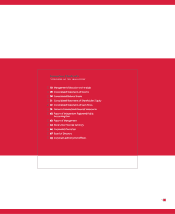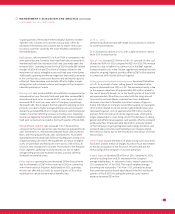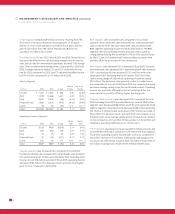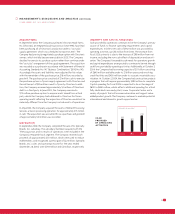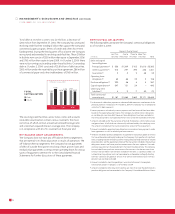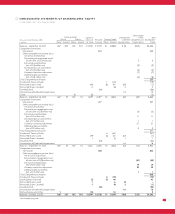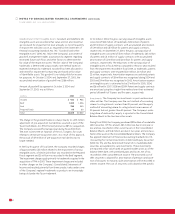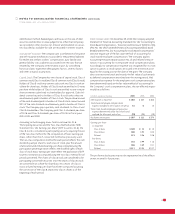Tyson Foods 2004 Annual Report Download - page 27
Download and view the complete annual report
Please find page 27 of the 2004 Tyson Foods annual report below. You can navigate through the pages in the report by either clicking on the pages listed below, or by using the keyword search tool below to find specific information within the annual report.
25
MANAGEMENT’S DISCUSSION AND ANALYSIS (CONTINUED)
In December 2004, the Financial Accounting Standards Board (FASB)
issued Statement of Financial Accounting Standards No. 151,
“Inventory Costs” (SFAS No. 151). SFAS No. 151 requires abnormal
amounts of inventory costs related to idle facility, freight handling
and wasted material expenses to be recognized as current period
charges. Additionally, SFAS No. 151 requires that allocation of fixed
production overheads to the costs of conversion be based on the
normal capacity of the production facilities. The standard is effec-
tive for fiscal years beginning after June 15, 2005. The Company
believes the adoption of SFAS No. 151 will not have a material
impact on its consolidated financial statements.
On October 22, 2004, the President signed into law the American
Jobs Creation Act of 2004 (the Bill). The Company is currently in the
process of evaluating the Bill.
In March 2004, the Emerging Issues Task Force (EITF) reached a
consensus on Issue No. 03-6, “Participating Securities and the
Two-Class Method under FASB Statement No. 128, Earnings per
Share.” This issue involves the computation of earnings per share
for companies that have multiple classes of common stock or
have issued securities other than common stock that participate
in dividends with common stock (participating securities). The EITF
concluded that companies having participating securities are required
to apply the two-class method to compute earnings per share. The
two-class method is an earnings allocation method under which
earnings per share is calculated for each class of common stock and
participating security considering both dividends declared (or accu-
mulated) and participation rights in undistributed earnings as if all
such earnings had been distributed during the period. The Company
adopted EITF Issue No. 03-6 in the fourth quarter of fiscal 2004. As
required by EITF Issue No. 03-6, prior period earnings per share have
been restated as follows:
2003 2002
Earnings per share as previously reported
Basic $0.98 $1.10
Diluted 0.96 1.08
Earnings per share, restated in
accordance with EITF Issue No. 03-6
Class A Basic 1.00 1.13
Class B Basic 0.90 1.02
Diluted 0.96 1.08
In December 2003, the FASB revised Statement of Financial Accounting
Standards No. 132, “Employers’ Disclosures about Pensions and Other
Postretirement Benefits” (SFAS No. 132). The revision of SFAS No. 132
requires expanded disclosures for defined benefit plans. The standard’s
revisions are effective for fiscal years ending after December 15, 2003,
and for interim periods beginning after December 15, 2003. See
Note 15 to the Consolidated Financial Statements for pensions and
other postretirement benefits disclosures.
In December 2003, the Medicare Prescription Drug, Improvement
and Modernization Act of 2003 (the Act) was signed. The Act allows
a possible subsidy to retirement health plan sponsors to help offset
the costs of participant prescription drug benefits. In March 2004, the
FASB issued Staff Position No. 106-2, “Accounting and Disclosure
Requirements Related to the Act” (the Position). The Position is effec-
tive for interim or annual periods beginning after June 15, 2004. The
Position allows plan sponsors to recognize or defer recognizing
the effects of the Act in its financial statements. Specific accounting
guidance for this federal subsidy is pending and, when issued, could
require the Company to change previously reported information.
The Company’s accumulated postretirement benefit obligation and
net periodic pension cost do not reflect the effects of the Act.
The Company has elected to defer accounting for the Act and has
estimated any future effect on its consolidated financial statements
will not be material.
In January 2003, the FASB issued Interpretation No. 46, “Consolidation
of Variable Interest Entities, an Interpretation of Accounting Research
Bulletin No. 51” (the Interpretation). The Interpretation requires the
consolidation of variable interest entities (VIE) in which an enterprise
absorbs a majority of the entity’s expected losses, receives a majority
of the entity’s expected residual returns, or both, as a result of
ownership, contractual or other financial interests in the entity.
Previously, entities were generally consolidated by an enterprise
that had a controlling financial interest through ownership of a
majority voting interest in the entity. In December 2003, the FASB
issued a revision of the Interpretation (the Revised Interpretation 46).
Revised Interpretation 46 codifies both the proposed modifications
and other decisions previously issued through certain FASB Staff
Positions and supersedes the original Interpretation to include:
(1) deferring the effective date of the Interpretation’s provisions for
certain variable interests, (2) providing additional scope exceptions
for certain other variable interests, (3) clarifying the impact of troubled
debt restructurings on the requirement to reconsider (a) whether an
entity is a VIE or (b) which party is the primary beneficiary of a VIE
and (4) revising Appendix B of the original Interpretation to provide
additional guidance on what constitutes a variable interest. Under
the new guidance, application of the Revised Interpretation 46 is
required in financial statements of public entities that have interests
in structures that are commonly referred to as special-purpose
entities for periods ending after December 15, 2003, and for all other
types of variable interest entities is required in financial statements
for periods ending after March 15, 2004. The Company’s adoption of
Revised Interpretation 46 did not have a material impact on its
consolidated financial statements.




